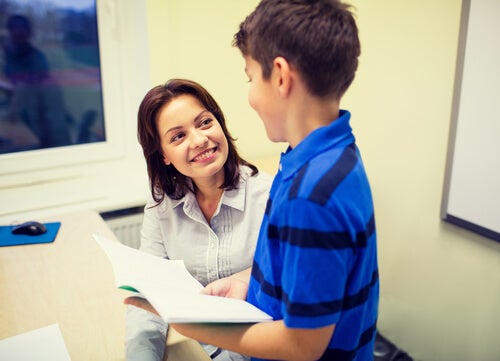Psychological Treatment for ADHD in Children

ADHD is a disorder that starts in childhood. It consists of a persistent behavior pattern of lack of attention, hyperactivity, and impulsiveness. These behaviors may be more frequent and intense depending on the child’s age and development. Furthermore, the condition can significantly interfere with their performance and daily activities. Therefore, it’s important to learn about the psychological treatment for ADHD in Children.
ADHD affects between three and seven percent of the school-age population. For this reason, it’s considered to be a public health problem. In fact, children with this disorder have a bigger chance of academic failure. In addition, they have behavioral issues and find it difficult to develop social-family ties.
It’s rare for ADHD to occur on its own. As a matter of fact, more than 85 percent of patients with this disorder also have another ailment. For instance, almost 60 percent present two comorbidities. The most common are oppositional defiant disorder, anxiety disorders, and behavioral disorders.

Before psychological treatment for ADHD
Treatment for ADHD must be multimodal and individualized. Furthermore, it must take into account both the patient and their family. Above all, the goal is to reduce the symptoms, the complications, and any negative impact. Multimodal and/or combined treatment for ADHD involves three approaches: pharmacological treatment, cognitive behavioral therapy, and psychoeducational treatment (with parents and teachers).
The general philosophy of cognitive-behavioral therapy is to reward the positive, instead of punishing the bad. In addition, it teaches self-control techniques, social skills, and problem-solving techniques.
The goals of the treatment
In children up to 6 years old with ADHD, treatment usually focuses on training their parents. However, with older children, parental training combines cognitive behavioral therapy with self-instruction and soft skills.
The goals of cognitive-behavioral therapy are:
- Self-regulation.
- Control of irritability.
- Improvement in communication.
Training for parents of ADHD sufferers
Most importantly, the psychoeducational module of training involves parents and gives them information on ADHD. It also creates and motivates positive feelings towards the child. Lastly, it gives them strategies on how to solve problems and improve the family environment.
Parents can train as a group or individually. However, several studies have shown that group training is more effective and efficient. With this training, they learn the following techniques:

Reinforcement and punishment
- Encouragement and reinforcement of positive attitude and behavior in the child.
- Suppression of negative behavior.
- After learning to use reinforcement and suppression, they can use the technique of differential reinforcement of low rates (DLR).
Token economy
The token economy works better if:
- The rules are clear.
- They combine token economy with reinforcement, suppression, and response cost.
- The children know at all times what they need to do and how to do it.
Overcorrection
- Restitutional overcorrection. This means they ask the child or student to fix the damage they’ve done. It’s about correcting the negative effects of bad behavior. In fact, to return things to the way they were or improve them.
- By repetition or positive reinforcement. In this case, the child repeats a positive behavior as an alternative to the one he expressed before.
Training the teachers
Above all, teachers need specific support to deal with children with ADHD. In fact, the basic scheme of orientation programs for teachers is very similar to the one for parents. However, the goals here focus on school rules, school work, and social competence.
The phases of training for teachers are below.
Instructing teachers on learning about ADHD
- Knowing what ADHD is, helps to change behavior biases.
- Understanding the special needs of students with ADHD.
Teaching them behavior modification techniques
- Techniques to increase the right behavior: reinforcement, the Premack Principle, contingencies agreements, and token economy.
- Techniques to reduce the wrong behavior: suppression, response cost, and isolation (time out).
Training teachers on organization strategies and self-directedness of behavior
- The teachers explain to the student how to develop self-control and solve personal and interpersonal problems.
Make it easier to adapt to school
- Using instructional procedures, organizational and environmental changes in the classroom can make it easier to learn and succeed academically.
Using reinforced self-assessment
Works on making the student with ADHD aware of how they behave.
- Along with the rest of the class, setting the school rules in place.
- Training them on their self-assessment skills.
- Token economy.
First, teachers apply it to the entire class, then to the student with ADHD.
Give guidance and follow-up on psychological treatment for ADHD
In the final two weeks of the program, the teachers follow up on how it’s been carried out. In addition, they conclude whether there’ve been significant and positive effects on impulsiveness, hyperactivity, and attention deficit.
Training the child
Cognitive psychotherapy involves a series of psychological techniques that can modify certain thoughts, believes, or attitudes in a patient. With ADHD, this therapy works on restructuring the child’s thoughts and changing their behavior. However, this type of psychotherapy should always be implemented by experienced and trained therapists.
Frequently, together with attention deficit and hyperactivity, children with ADHD may have problems with socialization and behavior. In such cases, it’s useful to train them in soft skills, problem-solving techniques, and self-help strategies.
Self-regulation
Neuroimaging techniques show that children with attention deficit, with or without the element of hyperactivity, show a delay in the maturing of certain areas of their brain. These areas relate to attention and self-control.
To improve their self-control, the most used techniques are cognitive. Essentially, cognitive techniques use internal language to regulate behavior.
- With self-reflection, the child learns to be aware of their behavior.
- With self-reinforcement, the child expects to be rewarded for their adaptive behavior.
- Training with self-instruction (Meichembaum & Goodman, 1971) aims to teach the child to speak to themselves internally. This will make it easier for them to think and be aware of what they do or think.
In short, these cognitive techniques seek the child’s ability to relate their behavior with past consequences. In this way, they’ll be able to evaluate their behavior according to the rules of their home, school, or other social environments.
Improving their communication skills
Communication programs for children with ADHD aim to increase their self-awareness, analyze their relationships with others, and solve their interpersonal issues. Some of the techniques these programs use are:
- Problem-solving techniques. They calm the child down and help them control their hyperactive and impulsive behavior. With small children, a different variant is used, known as the Tucker Turtle technique.
- With teenagers, a contingency clause is mostly used to get them to compromise. The aim is to reach an agreement that all parties agree on (student-teacher, child-parent, etc).
- Training on soft skills. Working with teenagers in group sessions is an efficient method. It stimulates good self-esteem and reinforces their individual goals which they then work on with their families, teachers, and therapist.

Neurofeedback
This is a training program that uses personal control over brainwaves using electroencephalographic technology. Above all, the goal of neurofeedback is training the patient to decrease their slow waves (theta) and/or increase their rapid waves (beta).
With neurofeedback, clinicians try to alter the “abnormal” state to one that’s similar to children with normal development. In other words, they aim to give children certain control of their brainwaves to alleviate the symptoms related to ADHD.
Say – do correspondence
This training was designed as an alternative to self-instruction training. Its goal is to reinforce those times where the child says they did something and they did actually do it.
It also aims to reinforce their behavior when they say they’ll do something and they do what they said they would.
ADHD is a disorder that starts in childhood. It consists of a persistent behavior pattern of lack of attention, hyperactivity, and impulsiveness. These behaviors may be more frequent and intense depending on the child’s age and development. Furthermore, the condition can significantly interfere with their performance and daily activities. Therefore, it’s important to learn about the psychological treatment for ADHD in Children.
ADHD affects between three and seven percent of the school-age population. For this reason, it’s considered to be a public health problem. In fact, children with this disorder have a bigger chance of academic failure. In addition, they have behavioral issues and find it difficult to develop social-family ties.
It’s rare for ADHD to occur on its own. As a matter of fact, more than 85 percent of patients with this disorder also have another ailment. For instance, almost 60 percent present two comorbidities. The most common are oppositional defiant disorder, anxiety disorders, and behavioral disorders.

Before psychological treatment for ADHD
Treatment for ADHD must be multimodal and individualized. Furthermore, it must take into account both the patient and their family. Above all, the goal is to reduce the symptoms, the complications, and any negative impact. Multimodal and/or combined treatment for ADHD involves three approaches: pharmacological treatment, cognitive behavioral therapy, and psychoeducational treatment (with parents and teachers).
The general philosophy of cognitive-behavioral therapy is to reward the positive, instead of punishing the bad. In addition, it teaches self-control techniques, social skills, and problem-solving techniques.
The goals of the treatment
In children up to 6 years old with ADHD, treatment usually focuses on training their parents. However, with older children, parental training combines cognitive behavioral therapy with self-instruction and soft skills.
The goals of cognitive-behavioral therapy are:
- Self-regulation.
- Control of irritability.
- Improvement in communication.
Training for parents of ADHD sufferers
Most importantly, the psychoeducational module of training involves parents and gives them information on ADHD. It also creates and motivates positive feelings towards the child. Lastly, it gives them strategies on how to solve problems and improve the family environment.
Parents can train as a group or individually. However, several studies have shown that group training is more effective and efficient. With this training, they learn the following techniques:

Reinforcement and punishment
- Encouragement and reinforcement of positive attitude and behavior in the child.
- Suppression of negative behavior.
- After learning to use reinforcement and suppression, they can use the technique of differential reinforcement of low rates (DLR).
Token economy
The token economy works better if:
- The rules are clear.
- They combine token economy with reinforcement, suppression, and response cost.
- The children know at all times what they need to do and how to do it.
Overcorrection
- Restitutional overcorrection. This means they ask the child or student to fix the damage they’ve done. It’s about correcting the negative effects of bad behavior. In fact, to return things to the way they were or improve them.
- By repetition or positive reinforcement. In this case, the child repeats a positive behavior as an alternative to the one he expressed before.
Training the teachers
Above all, teachers need specific support to deal with children with ADHD. In fact, the basic scheme of orientation programs for teachers is very similar to the one for parents. However, the goals here focus on school rules, school work, and social competence.
The phases of training for teachers are below.
Instructing teachers on learning about ADHD
- Knowing what ADHD is, helps to change behavior biases.
- Understanding the special needs of students with ADHD.
Teaching them behavior modification techniques
- Techniques to increase the right behavior: reinforcement, the Premack Principle, contingencies agreements, and token economy.
- Techniques to reduce the wrong behavior: suppression, response cost, and isolation (time out).
Training teachers on organization strategies and self-directedness of behavior
- The teachers explain to the student how to develop self-control and solve personal and interpersonal problems.
Make it easier to adapt to school
- Using instructional procedures, organizational and environmental changes in the classroom can make it easier to learn and succeed academically.
Using reinforced self-assessment
Works on making the student with ADHD aware of how they behave.
- Along with the rest of the class, setting the school rules in place.
- Training them on their self-assessment skills.
- Token economy.
First, teachers apply it to the entire class, then to the student with ADHD.
Give guidance and follow-up on psychological treatment for ADHD
In the final two weeks of the program, the teachers follow up on how it’s been carried out. In addition, they conclude whether there’ve been significant and positive effects on impulsiveness, hyperactivity, and attention deficit.
Training the child
Cognitive psychotherapy involves a series of psychological techniques that can modify certain thoughts, believes, or attitudes in a patient. With ADHD, this therapy works on restructuring the child’s thoughts and changing their behavior. However, this type of psychotherapy should always be implemented by experienced and trained therapists.
Frequently, together with attention deficit and hyperactivity, children with ADHD may have problems with socialization and behavior. In such cases, it’s useful to train them in soft skills, problem-solving techniques, and self-help strategies.
Self-regulation
Neuroimaging techniques show that children with attention deficit, with or without the element of hyperactivity, show a delay in the maturing of certain areas of their brain. These areas relate to attention and self-control.
To improve their self-control, the most used techniques are cognitive. Essentially, cognitive techniques use internal language to regulate behavior.
- With self-reflection, the child learns to be aware of their behavior.
- With self-reinforcement, the child expects to be rewarded for their adaptive behavior.
- Training with self-instruction (Meichembaum & Goodman, 1971) aims to teach the child to speak to themselves internally. This will make it easier for them to think and be aware of what they do or think.
In short, these cognitive techniques seek the child’s ability to relate their behavior with past consequences. In this way, they’ll be able to evaluate their behavior according to the rules of their home, school, or other social environments.
Improving their communication skills
Communication programs for children with ADHD aim to increase their self-awareness, analyze their relationships with others, and solve their interpersonal issues. Some of the techniques these programs use are:
- Problem-solving techniques. They calm the child down and help them control their hyperactive and impulsive behavior. With small children, a different variant is used, known as the Tucker Turtle technique.
- With teenagers, a contingency clause is mostly used to get them to compromise. The aim is to reach an agreement that all parties agree on (student-teacher, child-parent, etc).
- Training on soft skills. Working with teenagers in group sessions is an efficient method. It stimulates good self-esteem and reinforces their individual goals which they then work on with their families, teachers, and therapist.

Neurofeedback
This is a training program that uses personal control over brainwaves using electroencephalographic technology. Above all, the goal of neurofeedback is training the patient to decrease their slow waves (theta) and/or increase their rapid waves (beta).
With neurofeedback, clinicians try to alter the “abnormal” state to one that’s similar to children with normal development. In other words, they aim to give children certain control of their brainwaves to alleviate the symptoms related to ADHD.
Say – do correspondence
This training was designed as an alternative to self-instruction training. Its goal is to reinforce those times where the child says they did something and they did actually do it.
It also aims to reinforce their behavior when they say they’ll do something and they do what they said they would.
This text is provided for informational purposes only and does not replace consultation with a professional. If in doubt, consult your specialist.







